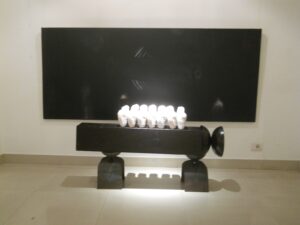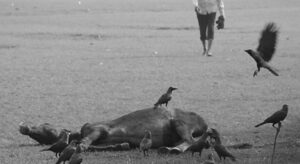(Catalog Essay: Nature Morte Gallery, New Delhi, India, 2010)
A large canvas is wrapped in taped newspaper sheets; Barack Obama and Paris Hilton peek out from speech bubbles; cartoon clips and Sharukh Khan appear in broken eye-glasses; two pairs of conjoined, attired legs engage in yoga positions; a headless zebra stands on a wavy checkered floor; a shadow/silhouette of a self-portrait bust on a wooden pedestal speaks news clips…… Such is the wide array of disjointed images populating Jayanta Roy’s canvases. Offered in deceptively simple compositions, the quotidian motifs seem to float above the stark white or slightly tinted ground of the canvas. So simple, in fact, that they often intimidate an uninitiated viewer. “That’s it?!” is the likely response.
Such a reaction isn’t a bad start at all, for the apparent superficiality of Roy’s work is indeed part of its content. But if one is then initiated into its aesthetic, one discovers that its drama is more cerebral than retinal. The deception isn’t a frivolous trick designed simply to dupe the viewer, but hides a complex dialectic between fiction and reality, between meditation and mediation, presented through an artifice that has always been fundamental to art. Through a game of simultaneous exposure and concealment, Roy’s work asks many old questions in a contemporary language. And in so doing, it claims a niche in the legacy of similar practices in recent art. A very brief survey of that history, therefore, is crucial to any critical look at Jayanta Roy’s images.
Art after the “end of art”
When New York replaced Paris as the hub of Western art during the early phase of the Cold War, Abstract Expressionism became synonymous with New American Art. At that specific art-historical moment, argued the influential critic Clement Greenberg, painting’s task was to engage in a self-critique to establish its autonomy as a medium and distance itself from what he called kitsch. It was to explore its own character and limits, such as opticality and flatness, by purging from itself traces of all the other arts, such as illusionism (sculpture) and narrative (literature). The eventual collapse of the subject into the object, he maintained, would make painting increasingly self-referential, signifying nothing but itself. Grounded in the Hegelian ideas of the limits of representation, this rhetoric was instrumental in generating a discourse of high art and personality cult that brought American art to the international arena in the 1950s to bolster the nation’s newly acquired political and economic image.
This hegemony, however, was soon challenged; first by such artists as Robert Rauschenberg and Jasper Johns, and then by movements like Pop, Photorealism, and Minimalism. They refuted the modernist assertion of the artist’s unmediated access to representation, insisting instead that all perceptions in a televised consumer culture were thoroughly mediated. For them, simulation –signs replicating other signs without any preceding referents– replaced emulation. In response to Greenberg’s highbrow modernism, they deliberately embraced kitsch as their source, and self-consciously painted a variety of ubiquitous signs of American popular culture. Images of soup cans, dollar bills, flags, automobiles and diners became quintessentially self-referential representations– signs of mundane signs.[i] But contrary to the modernist claim that self-referentiality paradoxically secured painting’s privileged status, the self-referentiality of these artists signaled the “end of art”. There seemed only a contextual difference between their at-your-face, hyperreal art and commodity.
It wasn’t until the mid-1970s that this counter-argument to modernism was codified, under the influence of French critical theory, into an alternative paradigm. Though initially an American discourse, this theoretical stance soon made its impact on European art, and became so influential by 1981 that it made “the modernist archetype of the isolated and estranged artist…irrelevant, and even obsolete…”[ii] But as Arthur Danto observes, far from being a literal death sentence of art, it was a “political declaration…a revolutionary cry” announcing that the emulative approach to representation known since the 19th century “had achieved closure.”[iii] Alternatively, representation’s mediating role, its self-referentiality resulting from its appropriation of kitsch, and the artist’s self-conscious gesture had countless ramifications in both America and Europe under the Conceptual umbrella. Genres were collapsed, authorship was questioned, and the work of art became an open-ended text; not, in Roland Barthes’ view, simply by a deeper investigation of it, “but, rather, according to a serial movement of disconnections, overlappings, variations.”[iv] Paintings were now meant to be read for significations, rather than consumed as a holistic visual experience. They were like puzzles with missing pieces. It was up to the viewer/reader to fill the gaps.
Modernism in a postcolonial milieu
Since this is originally an occidental story, one is, of course, entitled to ask what relevance it has for the modern art of a country like India. For one thing, it would be unabashedly chauvinistic to expect that if modernism –or whatever else– is dead in New York, it has to be dead at once everywhere else on the planet. The socio-economic and cultural conditions in America that provoked the logical self-negation of representation and its reinvention as a mediated practice were totally absent from the Indian scene in the 1970s, which is why the modernist aesthetic had an entirely different import for Indian artists. In other words, when modernism was considered sterile in New York and Paris, it stood for progress in Bombay and Calcutta, and for good reasons.
Following India’s independence from colonial rule, such groups as the Bombay Progressives and the Calcutta Group diversely adapted the occidental model –primarily European figurative modernism– to various local traditions to forge a new pictorial aesthetic. Thus reinterpreted, this Indian modernism was no more derivative than the work of the European Primitivists who appropriated non-Western arts early in the 20th century. Thomas McEvilley summarizes it well. “To say that elements of our past visual languages are being adopted by Indian artists is not to say that our language is being worn like something handed down”, he writes. “Like loanwords passing from one language to another, visual elements enter new linguistic configurations and purposes in different cultures.”[v]
But in the last couple of decades, that formative era of Indian modernism has made way for a transformative epoch. Ubiquity of technology; a booming consumer culture due to liberalization of the economy; rise of the media with its unfathomable power to shape perceptions of illusion and reality; and increasing mobility of a nouveau-riche middle-class have challenged, if not completely dismantled, the ontological certainty of life in urban Indian spaces, where most of today’s artists work and live. What is more, a decentered art patronage system has radically altered the older dynamics of India’s art circuit. It leaves little room for doubt that the modernist aesthetic, once such a fecund creative tool, is largely untenable in the current context. Thoroughly institutionalized, its purist notions of highbrow culture and kitsch and its insistence on the separation of the arts now seem tragically outmoded. As a matter of fact, one can legitimately ask whether painting or sculpture in its conventional form –produced primarily for visual consumption, appreciated in its authorial aura, yet totally commoditized–is capable at all of representing the current urban Indian experience.
Such changes, however, do not imply a re-enactment of the “end of art” scenario in India—historically speaking, that’s not even possible. What it does mean, though, is that it is highly opportune, even crucial for Indian artists to rethink representation. And of course, many of them from the younger generations across India –Jayanta Roy among them– have been doing just that for several years now. They attempt to see art in discursive light, rather than as a static entity. Questioning the conventional notions of the conception, making, and consumption of a work of art, they exploit its textual possibilities and reinvent it as a hybrid across genres, mediums, and techniques. Dissecting and scrutinizing a legacy to profit from it is much like tearing up a site and testing its soil before building a settlement on it.
Since Jayanta Roy is based in Kolkata (Calcutta), a brief comment on this city’s contemporary art scene would be relevant in this context. Historically known for its cultural pursuits, Kolkata once made serious contributions to the shaping of a modern art; key figures of that vibrant era are still rightfully revered. But it is a baffling reality that sharply contrasting its film, theater, literature, and music, much of Kolkata’s current art appears noticeably dull and dated. Only a handful of Kolkata-based younger artists are interested in experimenting with new possibilities, taking what one observer calls “transgressive leaps”.[vi] For reasons too complex to explore here, the majority hangs on to the modernist legacy with a parochial zeal, but without much awareness of its diminished relevance to the current era. Unwillingness to interrogate that legacy has bred endless, impotent reiterations of an overused convention. What is more, the critical discourse of art around such practice makes almost no effort to address this issue. In fact, with little criticality, it hardly even qualifies as a discourse. Any effort to discuss this state of stagnancy is frequently met with either an allegation of Euro/Amerocentrism, or an equally naïve claim to regional uniqueness.
Medi(t)ations of a decentered self
Instead of playing it safe like so many of his Kolkata peers, Jayanta Roy ventures out of his comfort zone to challenge himself and redefine his creative enterprise. His pictorial strategies often appear facile, but a close look reveals their sound historical and conceptual foundations. If allegory involves two overlapping texts, where one is read through the other, as Craig Owens suggests, then Roy’s paintings are allegories indeed, as they confront and subvert the myth of painting. [vii] While the scale of most of his canvases recalls largeness as a historical marker of the prestige of painting, his exploitation of the canvas actually undermines that status. Agitated surface, idiosyncratic marks, unpredictable effects– all such traits characterizing so much of modernist art are deliberately rejected. Whether off-white or of a light bluish tone, portions of the exposed canvas –and there is plenty of that– is rendered numbingly neutral. The potency of Roy’s paintings depends precisely on this negation of the pictorial ground. Any unevenness in its texture or visible brushwork would diminish its efficacy.
And yet, paradoxically, it is painting. The canvas, as an opaque body and material support, is palpably present. Populating the space with striking economy and clarity, images seem to float above this ground, rather than being grounded in it. In fact, Roy’s canvases emerge much less as a ground, where forms are integrated to canvas and paint, than as a field, where signification occurs without any fixity of signs. Trompe l’oeils executed with remarkable virtuoso interact with line drawings, silhouettes, and transfers from reproductions. Outlines and silhouettes serve as surrogates for transparency and opacity, effects common to conventional painting.
Roy’s motifs provoke one to react to their apparent shallowness or seemingly irrational juxtapositions. But one eventually learns to read them as discontinuous utterances of a schizophrenic speech—signifiers with flexible syntaxes that are encoded statements about a Bangali-Indian artist’s experiences in a globalizing world, offered through a self-critique rich in wit and irony. Consider, for instance, the recurring speech bubble, which Roy borrows from the inventory of Pop art. Invented by the comic industry, it is a visualization of a concept (someone speaking), justified solely by the presence of a speaker, as a shadow’s existence is justified by the opaque body that casts it. The difference, however, is that a shadow –despite its intangibility– is a natural phenomenon; whereas a speech bubble exists exclusively as a two-dimensional visual sign at the service of language, which makes it more malleable in representation than a shadow. In both versions of Adda (2008), for example, Roy offers speech bubbles without any speakers, underscoring their role as rootless signifiers.

Adda I, 2008.
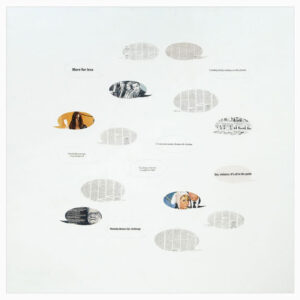
Adda II, 2009.
Adda is a peculiarly Bangali concept, which inadequately translates as chit-chat. Bangalis of all classes and walks crave for this seemingly endless, informal conversation with no specific topics or conclusion. With no sense of logical progress, adda is schizophrenic, functioning as if in a perpetual present. In Adda II (2009), arbitrary texts –echoing the arbitrariness of language itself– taken from newspapers and transferred to the canvas, are arranged in noticeable symmetry. Their speakers invisible, they float around like shadows without sources. The contents of the texts are inconsequential, as it usually is with any adda; one has only to imagine them as an echo of today’s immense network of information. In Adda I, speech bubbles are juxtaposed with a variety of human characters. Central to this canvas is an outlined, giant tea-cup, that indispensable component of adda. A crowd of similarly outlined people, reminiscent of children’s drawing-books, is punctuated by a few illusionistic portraits; yet the bubbles, some of which float outside the cup, don’t belong to any of them. The speaker’s role, crucial to the functional identity of a speech bubble, is thus systematically subverted.
What is significant, on the other hand, is the presence of visual images, –glimpses of such media icons as Manmohan Singh, Barack Obama, and Paris Hilton– replacing the text in some of the bubbles in Adda II. One of them even shows a cartoon clip, in which the characters’ own bubbles (not assigned, but only appropriated by Roy) further alter the ontology of the speech bubble. Further, in The Babu (2009), a thought bubble with the checkered pattern hovers above a realistic self-portrait. All of this is unequivocal evidence of Roy’s interest in manipulating the complex relation between words and images by drawing on the legacy of René Magritte’s 1928-29 painting The Treachery of Images. Together, linguistic and visual signs participate in a process of signification where any finality of meaning remains elusive.
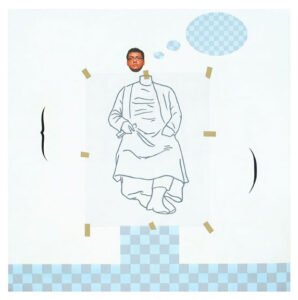
Babu, 2009.
The illusion of packaging tape again plays a seminal role in The Babu. What appears to be a traced drawing of a seated babu –a male member of the wealthy, leisure-loving Bangali feudal society of 19th-century Kolkata– is “taped” to the canvas. Following the accusation by some of his Kolkata peers that his emerging success in the art market has made him as well-off and pompous as a babu, Roy juxtaposes a realistic self-portrait with the outline of a headless babu. But the impossibility of reaching back across more than a century is obvious in the refusal of the two components to match up into a unified image. The two different parenthetical marks framing the central image further underscore this strategy of disparate appropriations, which is already apparent in the dislocation of the motifs and the illusion of tracing. The checkered pattern is called chhak in Bangla, but it also means scheme or strategy. The allegation that he is a chhakbaj (a schemer, a pejorative term) in the art world finds a tongue-in-cheek expression in the subdued pattern of the expensive marble flooring typical of a babu residence, and then in the artist’s thought bubble as an allusion to his schemes. In addition to confirming Roy’s play with words and images, it competently balances the composition.
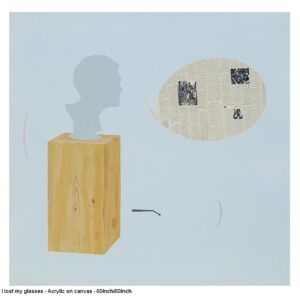
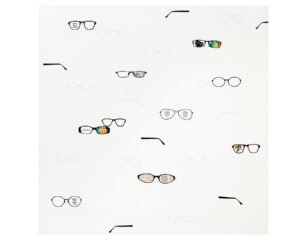
I Lost My Glasses, 2008.
20/20, 2009.
Confused by conflicting news reports on political violence, the artist in I Lost My Glasses (2008; not in the show) isn’t sure what to believe in any more; and this uncertainty is articulated in a series of logically impossible juxtapositions, resolutely decentering his authority. His self-portrait bust appears as a shadow/silhouette (in the absence of a referent, it’s impossible to tell the difference); this flat shape –an image of an image– rests on a trompe l’oeil pedestal; it has a speech bubble (how can a shadow/silhouette “speak”?); the text in the bubble is reversed; the newspaper photos are actually painted images. What is more, the author has lost his vision in this chaos, a handicap indicated by the broken temple at the bottom. A connection between speaking and seeing, between words and images, is impossible to overlook here, which causes Roy’s dissection of authorship to take a curious turn in 20/20 (2009). Strategically punctuated by broken temples, here an army of unusable eye-glasses –the author’s own lost among them– replaces speech bubbles as the mediating agent of perception. Vision here replaces speech, yet that substitution doesn’t resolve anything. First, speech itself is fragmented in Roy’s work, which leads to an equally fragmentary vision. Second, even as such, it is false vision, since there are no viewers behind these broken glasses. Their failure to mediate vision thus makes the title of this piece quite ironic.
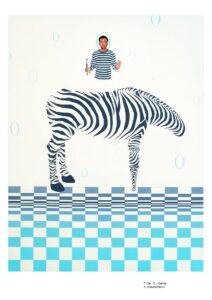
Op-o-Karma, 2008.
Title is crucial to Jayanta Roy’s paintings, because its narrative hint collides headlong with modernism’s disdain for narrative. In a few cases, the language game involving words and images adopts the Dada strategy of making use of pun in its discourse. For example, Op-o-Karma (2008; not in the show) makes a hybrid out of apakarma, a Bangla word meaning fruitless or even questionable work. In this context, Bangla and English collaborate to also signify the power of the artist’s act of producing optical illusion. It is a witty statement about Roy’s family’s initial allegation that he was engaged in useless pursuits vis-à-vis the subsequent satisfaction brought by his success as an emerging artist. While the zero, a marker of failure, turns into the artist’s halo; the zebra, the checkered pattern, and the stripes on his shirt serve as agents of artifice.
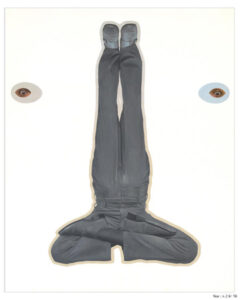
Arthayoga, 2009.
The cross-referencing in Arthayoga (2009; pronounced arthajog in Bangla) is also a case in point. Vertically composed on this large canvas are two pairs of conjoined legs in trousers and shoes, performing two different yoga positions at the same time. Executed with a severely limited palette, they are prominently outlined to mimic cut-outs. Two realistic eyes, horizontally located at opposite edges above the center, balance the strong verticality of the canvas. From this interaction emerges a curious face, with the legs as its nose and the gap between the seated feet as its front tooth. Artha in Bangla means both money and meaning, and jog is the Indian spiritual exercise as well as addition/inclusion. So arthayoga might mean financial gain; inclusion of meaning/layering of interpretations of this image/any image, which may enhance and/or be enhanced by financial gain; and/or more humorously, it might even imply inclusion of a new kind of yoga invented by the artist for his own success!
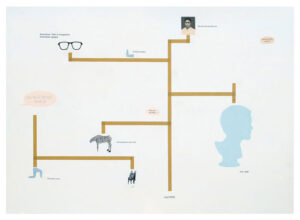
MysTree, 2009.
The most austere in its structure and execution in this vein is the latest work MysTree (2009), which forcefully asserts the textual role of Roy’s paintings. An ambiguous family-tree (mysTree) built with the well-known tape marks begins with a painted version of a photo of Roy’s late paternal uncle (who always encouraged him in his vocation), but then proliferates into recycled motifs from his other paintings. In other words, an imagined family tree mysteriously merges with an equally fictive genealogy of Roy’s own art. Somewhat like Barbara Kruger’s photo collages of the 1980s, each of them is accompanied by an abrupt, ambiguous statement, which makes the signification of the image all the more unstable. Retaining the mystery (of the “tree”) in its parts, this painting is unquestionably about representation itself. Beneath the brilliant touches of wit is the recognition of the contingency of the artist’s identity in making representations out of dislocated signs.
The rigorous transfer of reproductions, a process Jayanta Roy has perfected over the years, is instrumental in offering his entire corpus as an unfolding text. Both sides of a photocopy of the original are brushed with phenyl solution. Then the image is placed face down on the canvas and its back is rubbed with the back of a spoon to eliminate air bubbles. Once it dries up, all the fibers of the paper are painstakingly scraped off with the wet finger to reveal the transferred image. It is not a mere impression of a copy, since the entire ink of the photocopy is physically transferred to the canvas; rather, it raises intriguing questions regarding authenticity and mediation, and where it stands in reference to collage. Interactions between these and the painted images dramatize the tensions between emulation and simulation and among the various ontological states of the signs, thus elevating his work above the banal discussions of personal style and originality.
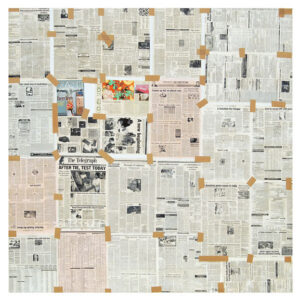
Wrapped Canvas, 2009.
The most remarkable examples in this category are the three versions of Wrapped Canvas (2009), two of which are in this show. Not only do they strongly evince Roy’s expertise in the image transfer method, but regardless of their place in the chronology of his paintings, they also represent a summation of his views of representation in a way that makes them a transitional marker between his paintings and sculptures. The entire canvas seems wrapped in taped newspapers; but that’s a deception. The black-and-white newspapers are transferred images, whereas the colored ones are painted; and the tape marks, as always, are also painted. So what does it represent? It may initially appear simply as an emulation of a finished painting, as if already sold, carefully wrapped and ready to go off to its new owner– a novel still-life. But such perception is an illusion as well. Rather, it is a painting about painting, an allegory that gives the “end of art” a historical nod before resuscitating representation with myriad disjointed signs appropriated from an expanding universe of simulacra. There is nothing so new about using an actual canvas to make statements about representation; Rauschenberg, Johns, Jim Dine, and many others have done it. But two factors testify to Roy’s inventiveness. First, all the images here are appropriated from the Indian context: mingled with disparate issues are reports on Indian art exhibitions and the art market, especially in the colored fragments. Second, transfers of reproductions here vastly outnumber painted images, a gesture that undermines the purist notion of painting.
It soon becomes clear that though the canvas is completely engulfed, there is nothing really to wrap, because the newspaper and the canvas surface are one and the same. This, however, does not make it a trompe l’oeil piece, because trompe l’oeil never exposes the objecthood of the canvas. Rather, locating itself in the shadows of Jasper Johns’s famous Flag series of the 1950s and Christo’s wrapped objects of the 1960s, this hyperreal image-as-object/object-as-image reframes, in the contemporary Indian context, the issues raised by its predecessors about the subject and object of representation vis-à-vis that of representation’s own objecthood. And while it plays with such ambiguities, the arbitrary tape marks on the transferred images emerge as a robotic parody of painterly brushwork. Instead of being the meditative ground so cherished by modernism, the canvas becomes a mediating field of fragmented motifs. It is this dialog between representation and objecthood that illuminates Roy’s sculptures.

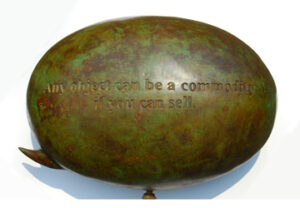 Speech Bubble, 2009.
Speech Bubble, 2009.
Trained primarily as a sculptor in a banal and dead-end schooling, Jayanta Roy focused more on painting in the last few years. It is via an intricate discourse between the two media, or rather, one between notions of two- and three-dimensionality that he has logically returned to making a handful of sculptures. The three pieces he exhibits brush with what Thomas McEvilley calls anti-sculpture, “a parody of the very idea of representation”. [viii] Rendered in bronze, The Speech Bubble (2009) not only parodies, but transgresses the limits of sculptural representation by giving an ontologically impossible objecthood to what is fundamentally a visual motif. But its hilarious non-functionality as an object is precisely what breathes a new life into it: the life of an art object. It reminds one of Brushstroke, Roy Lichtenstein’s monumental sculpture of 1996. Yet even in this new life and without a speaker, as usual, the object instigates the thorny debate over art and commodity; only unlike a pictured bubble, it takes advantage of its three-dimensionality to suggest that each is the flip-side of the other. The Table (2009), on the other hand, is an existing object (though made, not found), which is re-objectified into a sign; and in that, it is close to Subodh Gupta’s Airport Series of 2006 and Arun Kumar H.G.’s What’s in the Belly? of 2007. A simulated antique table with an enigmatic statement about broken promises carved on it in an archaic font, it uses the biblical reference as a point of departure toward a number of narrative possibilities. Who is speaking here? One wonders. But then again, does it really matter who it is? Carpenters made the object based on Roy’s ideas and a sketch. Just as artisans mediated its making, the object itself intervenes to postpone any decisive meaning of the statement.

 The Table (2009)
The Table (2009)
The promise in Jayanta Roy’s work lies in its innovative use of appropriations; nuanced sense of humor; incisive self-critique; acute awareness of social and art-historical discourses; and most importantly, in its self-presentation as a hybrid discursive space. It shares these traits in varying degrees with the work of several artists in the contemporary Indian scene, such as Atul Dodiya, Jitish Kallat, Arun Kumar H.G. and Subodh Gupta, most of whom are from his generation. It is not premature to expect that Roy’s current work will serve as a vital springboard for his future endeavors, which will explore uncharted creative avenues in more complex ways. For now, in the stifling space of Kolkata’s art milieu, where an obsolete rhetoric of high modernism still reigns supreme, it is a breath of fresh air.
Notes:
[i] Taylor, Mark C. The Picture in Question: Mark Tansey and the Ends of Representation. Chicago & London: University of Chicago Press, 1999: 21.
[ii] Gablik, Suzi. “Art Under the Dollar Sign”. Art in America, December 1981: 13.
[iii] Danto, Arthur. “Art after the End of Art”. Artforum, April 1993: 64.
[iv] Roland Barthes, “From Work to Text”, ibid., 171.
[v] McEvilley, Thomas. “The Common Air”, Artforum, summer 1986: 115.
[vi] Maity, Oindrilla. “Kolkata Now”, Art & Deal, 5(4), no.26: 111.
[vii] Owens, Craig. “The Allegorical Impulse: Toward a Theory of Postmodernism”. In Brian Wallis et el eds. Art after Modernism: Rethinking Representation. New York: New Museum of Contemporary Art, 1984: 204.
[viii] McEvilley, Thomas. Sculpture in the Age of Doubt. New York: Allworth Pres, 1999: 44.

